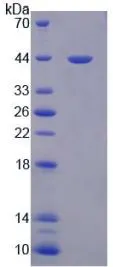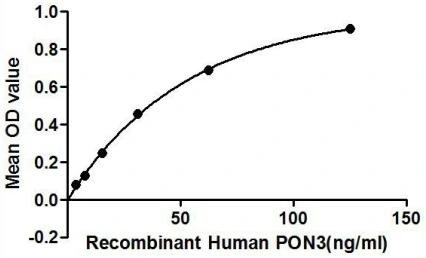
WB analysis of GTX00164-pro Human PON3 protein.
Human PON3 protein, His tag
GTX00164-PRO
ApplicationsFunctional Assay
Product group Proteins / Signaling Molecules
Protein IDQ15166
Overview
- SupplierGeneTex
- Product NameHuman PON3 protein (active)
- Delivery Days Customer9
- Application Supplier NoteParaoxonase 3 (PON3) is secreted into the bloodstream and associates with high-density lipoprotein (HDL). PON3 also rapidly hydrolyzes lactones and can inhibit the oxidation of low-density lipoprotein, a function that is believed to slow the initiation and progression of atherosclerosis. Besides, Paraoxonase 1 (PON1) has been identified as an interactor of PON3, thus a binding ELISA assay was conducted to detect the interaction of recombinant human PON3 and recombinant human PON1. Briefly, PON3 were diluted serially in PBS, with 0.01% BSA (pH 7.4). Duplicate samples of 100 microl were then transferred to PON1-coated microtiter wells and incubated for 2h at 37C. Wells were washed with PBST and incubated for 1h with anti-PON3 pAb, then aspirated and washed 3 times. After incubation with HRP labelled secondary antibody, wells were aspirated and washed 3 times. With the addition of substrate solution, wells were incubated 15-25 minutes at 37C. Finally, add 50 microl stop solution to the wells and read at 450nm immediately. The binding activity of of PON3 and PON1 was in a dose dependent manner.
- ApplicationsFunctional Assay
- CertificationResearch Use Only
- ConjugateUnconjugated
- Protein IDQ15166
- Protein NameSerum paraoxonase/lactonase 3
- Scientific DescriptionThis gene is a member of the paraoxonase family and lies in a cluster on chromosome 7 with the other two family members. The encoded protein is secreted into the bloodstream and associates with high-density lipoprotein (HDL). The protein also rapidly hydrolyzes lactones and can inhibit the oxidation of low-density lipoprotein (LDL), a function that is believed to slow the initiation and progression of atherosclerosis. Alternatively spliced variants which encode different protein isoforms have been described; however, only one has been fully characterized. [provided by RefSeq, Jul 2008]
- Storage Instruction-20°C or -80°C,2°C to 8°C
- UNSPSC12352202


